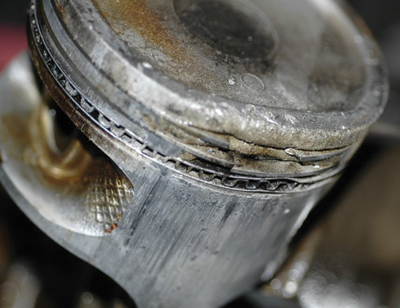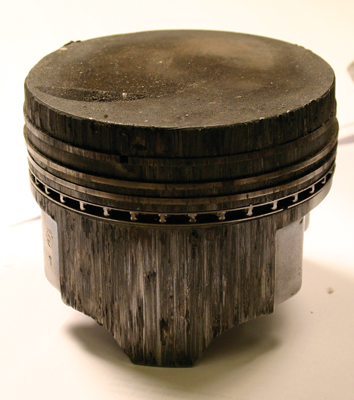ation of the end gaps on all three rings 180° apart.
• Make certain the cylinder bores are clean before you install the pistons and rings in the block. Use hot soapy water, scrub brush and plenty of elbow grease to thoroughly clean the bores. Wipe with a clean white rag to check for any residue, then lightly oil prior to assembly.
• Make sure the ring compressor is properly tightened so the rings don’t catch on the edge of the
cylinder as the piston is being pushed into the bore.
• For engine break-in, use a conventional oil or specific oil designed for breaking in engines. Then switch to a synthetic after 2,500 to 3,000 miles if you want the advantages of a synthetic motor oil.
Piston Breakdowns
In your internal dissection of the engine to address ring issues, you may also uncover piston damage that is contributing to driveability problems.
Common damage includes burned pistons, which is evident by a melted appearance, or a hole burned completely through the top of the piston.
The underlying cause is usually detonation and/or pre-ignition.
Basically, when you see this type of piston damage, it means the piston failed due to excessive heat in the combustion chamber. Aluminum can only withstand so much heat, and when it gets too hot, it melts.
Detonation occurs when the temperature and pressure inside a cylinder exceed the fuel’s octane rating. Instead of igniting when the spark plug fires, the air/fuel ignites spontaneously, much like a diesel engine.
This creates multiple flame fronts within the combustion chamber that collide and hammer the top of the piston, producing a metallic knocking noise called “spark knock.”
Common causes of detonation include a buildup of carbon deposits in the combustion chamber and on the top of the piston that increase compression, no EGR (exhaust gas recirculation), overadvanced ignition timing, a bad knock sensor, a lean fuel mixture, low quality gasoline that does not meet minimum octane requirements, or any cooling problems that causes the engine to run hotter than normal (coolant leak, low coolant level, bad water pump, stuck thermostat, restricted radiator, defective cooling fan, even exhaust restrictions that back up heat into the engine.
Pre-ignition occurs if a hot spot develops in the combustion chamber that ignites the air/fuel mixture before the spark plug fires. The hot spot may be the spark plug itself, an overheated exhaust valve, carbon deposits in the combustion chamber, or a sharp edge in the combustion chamber.
Common causes of pre-ignition include the wrong heat range spark plugs (too hot for the application), carbon deposits in the combustion chamber and on the tops of the pistons, a lean fuel mixture, detonation or anything that makes the engine run hotter than normal.
On engines that are turbocharged or supercharged, too much boost pressure and/or not enough fuel can burn a piston very quickly. So check the operation of the wastegate and boost control system. If the turbo system has been tweaked to deliver higher than stock boost pressure for more power, the turbo may be pushing more air into the engine than the stock injectors can handle, causing the fuel mixture to lean out and burn the piston.
An often-overlooked cause of piston burning can be a weak or dirty fuel injector. If an injector is not spraying enough fuel into the combustion chamber, the air/fuel mixture in that cylinder may become too lean, increasing the risk of detonation, pre-ignition and piston damage.
Technicians may diagnose the problem using a scan tool to check for lean codes and to look at fuel trim values. If a P0171 or P0174 code is found, or the long-term fuel trim readings are 10 or higher (indicating a lean mixture), the engine may have one or more weak or dirty injectors.
The only way to know for sure is to remove the injectors, clean them on a fuel injector cleaning machine, then flow-test all the injectors and compare the results. Any injector that does not flow within 5-8% of the rest should be replaced.
A technician may also encounter a “scuffed” piston in which the piston has been damaged by rubbing against the cylinder wall. This metal-to-metal contact smears the metal on the skirt of the piston and creates visible damage.
 Scuffed Pistons Can Be Caused By:
Scuffed Pistons Can Be Caused By:
• Too much heat in the combustion chamber;
• An overheating engine; or
• Inadequate lubrication.
The piston-to-cylinder clearances in most late-model engines is much less than it used to be to reduce piston rock and noise. Consequently, if the piston or cylinder gets too hot, the clearance goes away and you get metal-to-metal contact.
In instances where piston scuffing occurred due to a loss of lubrication, the underlying cause may be a low oil level in the crankcase (due to a lack of maintenance or an oil leak), low oil pressure (a worn oil pump), poor oil quality or oil breakdown (not changing the oil often enough).
When diagnosing a scuffed piston, note where the piston is scuffed. If the cause is overheating, the scuffing will mostly be on the upper ring lands and on the sides near the wrist pins.
There may also be oil carbon and lacquer burned onto the underside of the piston indicating it got too hot. Scuff marks on the lower skirt area often indicate a lack of lubrication (check the oil pump and pickup screen). Scuff marks on the edges or corners of the thrust sides of the piston may be the result of bore distortion. Scuffing on both thrust sides would indicate binding in the wrist pin.
Some original equipment pistons and many aftermarket performance pistons now have special anti-scuff skirt coatings to reduce the risk of scuffing.




